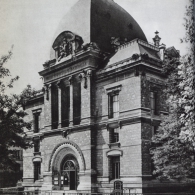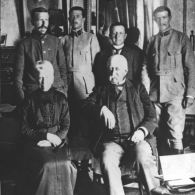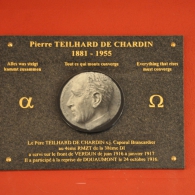Images
 The cliffs of Hastings near the place Teilhard studied theology during 1908-12. He spent most weekends searching for fossils in the 140-million-year-old fossiliferous stones from these cliffs.
The cliffs of Hastings near the place Teilhard studied theology during 1908-12. He spent most weekends searching for fossils in the 140-million-year-old fossiliferous stones from these cliffs.
 Fossils are discovered by cracking open fossiliferous stones,
Fossils are discovered by cracking open fossiliferous stones,
 When he finished his theological studies, Teilhard presented his fossil collection to the local Hastings museum, using this cigar box as one container.
When he finished his theological studies, Teilhard presented his fossil collection to the local Hastings museum, using this cigar box as one container.
 The Paris Museum of Natural History played a huge role in Teilhard’s life, providing him with knowledge and experience in identifying and analyzing fossils.
The Paris Museum of Natural History played a huge role in Teilhard’s life, providing him with knowledge and experience in identifying and analyzing fossils.
 Skeletons of modern primates at the Paris Museum of Natural History where Teilhard studied and worked.
Skeletons of modern primates at the Paris Museum of Natural History where Teilhard studied and worked.
 Teilhard participated in 67 battles (including Verdun) during his military service, without suffering a wound. He was twice decorated for valor.
Teilhard participated in 67 battles (including Verdun) during his military service, without suffering a wound. He was twice decorated for valor.
 Teilhard (left) with his parents and 3 of his brothers at the start of WWI. His brother Gonzague (next to Teilhard) was killed one month into the war. Olivier (right) was killed during the last month of the war.
Teilhard (left) with his parents and 3 of his brothers at the start of WWI. His brother Gonzague (next to Teilhard) was killed one month into the war. Olivier (right) was killed during the last month of the war.
 Today a WWI pill box watches in solitary silence over the rolling hills of Verdun, reminiscent of the mountains of Teilhard’s birthplace.
Today a WWI pill box watches in solitary silence over the rolling hills of Verdun, reminiscent of the mountains of Teilhard’s birthplace.
 Teilhard (on right) with fellow soldiers during WWI. This dramatic period of his life exposed him to the rough and tumble of military life and introduced him to men of all sorts.
Teilhard (on right) with fellow soldiers during WWI. This dramatic period of his life exposed him to the rough and tumble of military life and introduced him to men of all sorts.
 Muslim and Christian gravestones stretching side by side in the Verdun cemetery.
Muslim and Christian gravestones stretching side by side in the Verdun cemetery.
 A stained glass window in the Douaumont (Verdun) Memorial chapel depicts litter bearers, the role Teilhard played during the war.
A stained glass window in the Douaumont (Verdun) Memorial chapel depicts litter bearers, the role Teilhard played during the war.
 An evocative sculpture in the Douaumont (Verdun) Memorial depicts the care shown by comrades carrying the wounded.
An evocative sculpture in the Douaumont (Verdun) Memorial depicts the care shown by comrades carrying the wounded.
 Teilhard served in WWI for 4½ years. He declined the rank of officer-chaplain to serve as a litter-bearer in a North African Muslim regiment. “What emerged into my field of perception was literally a new Universe,” he wrote. He used all available time between stints on the front to write, expressing for the first time virtually all of the main threads of thought he would develop at length in later years.
Teilhard served in WWI for 4½ years. He declined the rank of officer-chaplain to serve as a litter-bearer in a North African Muslim regiment. “What emerged into my field of perception was literally a new Universe,” he wrote. He used all available time between stints on the front to write, expressing for the first time virtually all of the main threads of thought he would develop at length in later years.
 This plaque honoring Teilhard is mounted in the Douaumont Memorial in the Verdun battlefield.
This plaque honoring Teilhard is mounted in the Douaumont Memorial in the Verdun battlefield.
 With his ever-present geologist’s hammer, Teilhard examines a potentially fossiliferous rock.
With his ever-present geologist’s hammer, Teilhard examines a potentially fossiliferous rock.
 The Ordos Desert, where Teilhard composed his famous Mass on the World.
“Since I have neither bread, nor wine, nor altar, I will raise myself beyond these symbols, up to the pure majesty of the real itself; I, your priest, will make the whole earth my altar and on it will offer you all the labors and sufferings of the world.”
The Ordos Desert, where Teilhard composed his famous Mass on the World.
“Since I have neither bread, nor wine, nor altar, I will raise myself beyond these symbols, up to the pure majesty of the real itself; I, your priest, will make the whole earth my altar and on it will offer you all the labors and sufferings of the world.”
 The immense cave where the skull of “Peking Man” was discovered by Pei Wenzhong in 1929 – the most significant paleontological evidence of human evolution found to that date. Teilhard was the geological specialist on the team that excavated the site, bearing primary responsibility for dating the fossils and objects uncovered there.
The immense cave where the skull of “Peking Man” was discovered by Pei Wenzhong in 1929 – the most significant paleontological evidence of human evolution found to that date. Teilhard was the geological specialist on the team that excavated the site, bearing primary responsibility for dating the fossils and objects uncovered there.
 The bust of Peking Man on display in China’s Zhoukoudian Museum, built on the site of the famous discovery.
The bust of Peking Man on display in China’s Zhoukoudian Museum, built on the site of the famous discovery.
 In 1931 Teilhard was invited to become the official geologist for a Citroen-sponsored expedition across the full expanse of Asia to demonstrate Citroen’s newly developed all-terrain vehicles.
In 1931 Teilhard was invited to become the official geologist for a Citroen-sponsored expedition across the full expanse of Asia to demonstrate Citroen’s newly developed all-terrain vehicles.
 Paleontological expeditions were not casual affairs. They required transporting large amounts of equipment and tons of samples. Pack animals ranged from a few mules at the minimum to a full train of camels.
Paleontological expeditions were not casual affairs. They required transporting large amounts of equipment and tons of samples. Pack animals ranged from a few mules at the minimum to a full train of camels.
 Teilhard served in WWI for 4½ years. He declined the rank of officer-chaplain to serve as a litter-bearer in a North African Muslim regiment. “What emerged into my field of perception was literally a new Universe,” he wrote. He used all available time between stints on the front to write, expressing for the first time virtually all of the main threads of thought he would develop at length in later years.
Teilhard served in WWI for 4½ years. He declined the rank of officer-chaplain to serve as a litter-bearer in a North African Muslim regiment. “What emerged into my field of perception was literally a new Universe,” he wrote. He used all available time between stints on the front to write, expressing for the first time virtually all of the main threads of thought he would develop at length in later years.
 The Ordos Desert, where Teilhard composed his famous Mass on the World.
“Since I have neither bread, nor wine, nor altar, I will raise myself beyond these symbols, up to the pure majesty of the real itself; I, your priest, will make the whole earth my altar and on it will offer you all the labors and sufferings of the world.”
The Ordos Desert, where Teilhard composed his famous Mass on the World.
“Since I have neither bread, nor wine, nor altar, I will raise myself beyond these symbols, up to the pure majesty of the real itself; I, your priest, will make the whole earth my altar and on it will offer you all the labors and sufferings of the world.”
 The immense cave where the skull of “Peking Man” was discovered by Pei Wenzhong in 1929 – the most significant paleontological evidence of human evolution found to that date. Teilhard was the geological specialist on the team that excavated the site, bearing primary responsibility for dating the fossils and objects uncovered there.
The immense cave where the skull of “Peking Man” was discovered by Pei Wenzhong in 1929 – the most significant paleontological evidence of human evolution found to that date. Teilhard was the geological specialist on the team that excavated the site, bearing primary responsibility for dating the fossils and objects uncovered there.





















